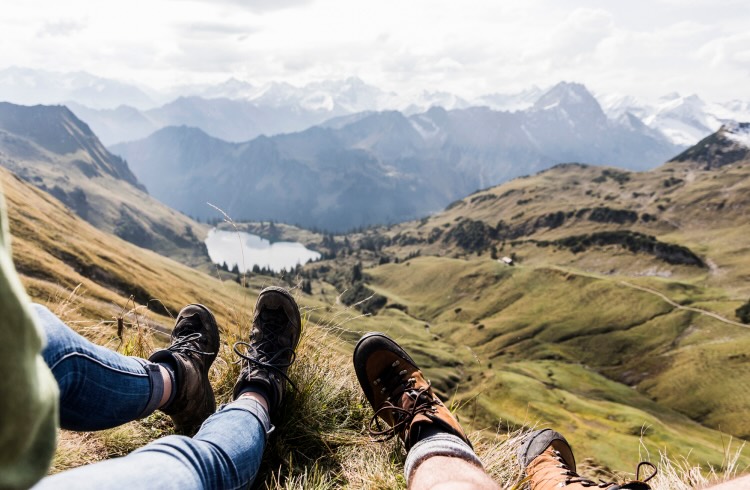How to Pick the Best Travel Shoes for Your Next Adventure
Choosing the right travel shoes depends a lot on what kind of activities you’ll be doing. Here’s what to look for in trail runners, water shoes, hiking boots, walking sandals and more.
 Photo © Getty Images / Westend61
Photo © Getty Images / Westend61
There’s a lot at stake when it comes to travel shoes. What you wear on your feet can make or break your adventure, affecting everything from comfort to safety.
The last thing you want on an active holiday is to be held back by shoes that don’t carry you the full mile. So, I'm here to guide you through selecting the perfect footwear for your next adventure, whether that’s scaling a mountain peak or navigating a walking tour.
How to choose the right travel footwear for your activity
Picking out your footwear requires just as much thought and consideration as choosing proper gear for your next camping trip.
Here’s what you should know.
Trail running shoes
Trail running shoes are the versatile all-stars of the footwear world. Whether you're tackling rocky paths, muddy tracks, or forest floors, these travel shoes are designed to handle it all.
They're best suited for off-road running, where you need more traction and stability than regular running shoes can offer. Here's what sets them apart.
- Tread pattern: A deep, aggressive tread is essential for grip on uneven or slippery surfaces. The more varied the terrain, the more aggressive the tread should be.
- Cushioning: While you want to feel the ground beneath you, adequate cushioning is essential for comfort and impact absorption.
- Breathability: Look for materials that wick moisture and allow your feet to breathe. Your feet will thank you, especially on long runs.
Here are some tips to keep you running smoothly with the right shoes on your feet.
- Gaiters can be your friend: If you're running in muddy or sandy conditions, consider using gaiters to keep debris out of your shoes.
- Replace regularly: Trail running shoes have a shorter lifespan than hiking boots. Keep an eye on the tread and cushioning, and replace as needed.
Hiking boots
When it comes to hiking, not all trails are created equal. Depending on where you’re going hiking, you may or may not need hiking boots.
In my experience, hiking boots are your go-to for moderate to challenging terrains, especially those with uneven surfaces, rocks, and steep inclines.
The boots are also helpful if you’re going to be walking for several hours a day or covering a considerable distance.
If you’re walking flat and easy trails, your regular trail or running shoes with decent tread may do just fine.
Let's talk about the essential features your hiking boots should have.
- Ankle support: Trust me, the last thing you want is a twisted ankle miles away from civilization. Look for boots with high collars that provide excellent ankle support.
- Grip: A good grip is non-negotiable. Opt for boots with deep lugs and a rubber outsole to keep you steady on slippery or uneven terrain.
- Waterproofing: Weather can be unpredictable. Waterproof or at least water-resistant boots are a must to keep your feet dry and comfortable.
Now that you know what to look for, here are some pro tips to elevate your hiking experience.
- Break them in: Never hit the trail with brand-new boots - it can result in blisters. Train for your hiking trip while wearing your boots. Wear them around the house or on short walks to break them in.
- Sock choice matters: A good boot is only as effective as the sock inside it. Opt for moisture-wicking socks to keep your feet dry and blister-free.
Walking sandals
Walking sandals are your best friends for casual strolls, city tours, and light hikes. Based on my experience, they're ideal for warm climates where breathability and comfort take precedence over heavy-duty support.
When it comes to walking sandals, comfort is king, but there are other features to consider.
- Arch support and cushioned footbeds: Flat, hard sandals are a no-go for extended walking. Look for options that provide your feet with the necessary support to keep moving.
- Material: Opt for quick-drying, durable materials like synthetic leather or nylon webbing.
- Adjustability: Adjustable straps are a must for a customized fit, especially if you'll be wearing them for long periods.
Armed with the right pair, here's how to make the most of your walking sandals.
- Clean them regularly: Use a gentle brush or sponge to remove dirt and debris. This will extend your travel shoes lifespan, especially if you've been in muddy or sandy conditions.
- Test the tread: A good walking sandal should offer enough grip to handle wet or slippery surfaces. But, always step carefully and test the tread before making any bold moves on the trail.
Snowshoes
Snowshoes are indispensable for winter hiking, snow trekking, and even some types of mountaineering.
The shoes work by distributing your weight over a larger surface area so you don’t sink deeply into the snow. In turn, they make it less strenuous and safe to enjoy your winter activities.
When you're trekking through deep snow or icy terrains, traditional footwear just won't cut it. Here are the key features that make a difference.
- Binding system: A secure binding system is crucial for attaching your boots to the snowshoes. Look for models with easy-to-adjust yet secure bindings.
- Crampons: These are the spikes or cleats on the bottom of the snowshoe. A good set of crampons provides the traction you need on icy or packed snow.
- Flotation: This refers to how well the snowshoe keeps you atop the snow. Wider snowshoes offer better flotation, but they can be cumbersome. Choose based on the depth and type of snow you'll encounter.
You've got your snowshoes; now let's talk about how to maximize their performance.
- Know your terrain: Different terrains (flat, rolling, or mountain) require different types of snowshoes. Make sure to choose a model that fits your specific needs.
- Proper sizing: Snowshoes come in various sizes based on your weight, including gear. Make sure to size appropriately for optimum performance.
Water shoes
Water shoes are often the unsung heroes of the travel shoe world. Ideal for kayaking, river crossings, and beach activities, they provide the protection and grip you need in aquatic environments.
Water shoes may seem straightforward, but a few key features can make all the difference.
- Quick drainage: Look for shoes with drainage holes or mesh panels that allow water to escape quickly.
- Grip: A good water shoe should have a grippy sole to prevent slips on wet surfaces.
- Toe protection: Opt for models with reinforced toes to protect against underwater hazards like rocks and coral.
You're all set for the water; now, let's ensure you get the most out of your aquatic adventures.
- Avoid cotton socks: If you're wearing socks with your water shoes, make sure they're made of quick-drying material like synthetic fibers.
- Rinse after use: Saltwater and chlorine can degrade the material over time. Always rinse your water shoes thoroughly after use.




No Comments